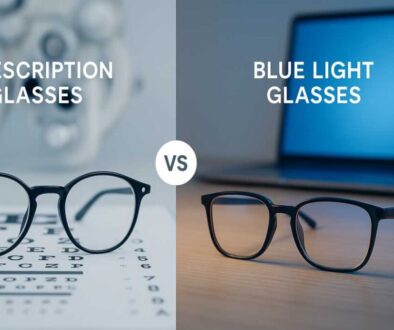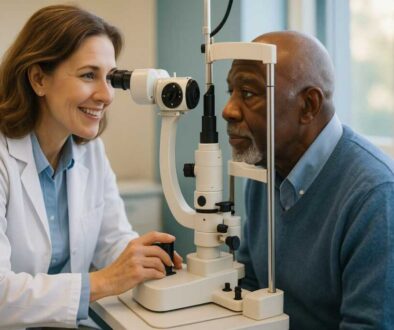Presbyopia After 40 | Fort Collins Eye Guide
If you’ve found yourself holding restaurant menus at arm’s length or squinting at your smartphone in Fort Collins’ bright Colorado sunlight, you’re not alone. You’re experiencing presbyopia—a natural vision change that affects nearly every adult in Northern Colorado. This condition typically begins in your early to mid-40s, and while those first moments of blurry text might feel frustrating, understanding what’s happening can help you find the right solution for your active lifestyle.
What Is Presbyopia? Understanding Your Changing Vision
Presbyopia comes from Greek words meaning “old eye,” but don’t let that discourage you. This universal vision change happens to everyone, regardless of whether you’ve had perfect vision your entire life or have worn glasses since childhood.
Around age 40, the natural lens inside your eye begins losing its flexibility, making it progressively harder to focus on close-up objects like books, computer screens, and your phone.
Think of your eye’s lens like a camera that can autofocus. When you’re young, this lens is soft and pliable, easily changing shape to shift focus from distant mountains along the Front Range to the text on your hiking map. As you age, the lens becomes thicker and more rigid due to protein changes within the eye tissue. By your mid-40s, this lens can no longer bend and adjust as easily, resulting in blurred near vision.
The process actually begins around age 12, but you don’t notice it until your 40s when your lens finally loses enough flexibility that normal reading distance becomes blurry. Recent research confirms that this occurs when the stiffness of the lens nucleus and cortex equalizes—typically happening between ages 35 and 40.
Common Signs You’re Experiencing Presbyopia in Fort Collins
Fort Collins residents often first notice presbyopia symptoms during everyday activities. Do any of these situations sound familiar?
Reading Challenges
You need brighter lighting to read menus at your favorite Old Town restaurants, or you’re holding your book or e-reader farther away to see the text clearly. The fine print on prescription labels or newspaper articles appears increasingly blurred, especially in dim lighting.
Digital Eye Strain
After hours of working on your computer or scrolling through your phone, you experience headaches, eye fatigue, or difficulty refocusing. Studies show that computer users with presbyopia report more eyestrain, neck pain, and back pain than those without the condition.
Activity Adjustments
Whether you’re crafting, knitting, doing woodwork in your garage, or reading trail maps before heading to Horsetooth Rock, you find yourself needing more light and holding materials at awkward distances.
Slower Visual Adjustment
When you look up from your phone to gaze at the foothills, your vision takes longer to refocus. This accommodation delay becomes more noticeable as presbyopia progresses.
These symptoms typically start subtly and worsen gradually until around age 60 to 65, when the progression generally plateaus. The good news? Effective treatments can restore your clear near vision.
Why Fort Collins’ Altitude and Sunlight Matter for Your Eyes
Living in Fort Collins at approximately 5,000 feet elevation with abundant sunshine affects your eye health in ways you might not realize.
Research suggests that people living closer to the equator or at higher altitudes with increased UV exposure may experience an earlier onset of presbyopia. Colorado’s intense sunlight and UV radiation can accelerate age-related lens changes, making comprehensive eye protection even more important for Northern Colorado residents.
This means wearing quality UV-protective sunglasses year-round isn’t just about comfort—it’s essential for maintaining long-term eye health and potentially slowing age-related vision changes. Whether you’re skiing at Eldora, hiking at Horsetooth, or simply walking downtown, your eyes need protection from Colorado’s high-altitude sun exposure.
Treatment Options: Finding What Works for Your Lifestyle
The good news is that Fort Collins residents have more presbyopia treatment options than ever before. From traditional reading glasses to cutting-edge eye drops and surgical solutions, you can find an approach that fits your active Colorado lifestyle.
Reading Glasses and Progressive Lenses
Over-the-Counter Readers
Available at pharmacies throughout Fort Collins, these inexpensive glasses ($7-$30) work well for people with no other vision issues who only need magnification for close work. They’re convenient for keeping a spare pair in your car, desk, or hiking pack.
However, ready-made readers have limitations. They provide the same prescription in both eyes and don’t account for individual differences in your vision, potentially causing eye strain, headaches, or dizziness if they’re not the right fit.
Custom Prescription Glasses
A comprehensive eye exam at a local Fort Collins optometrist ensures your glasses address your exact visual needs in each eye. Custom lenses can also correct for astigmatism, nearsightedness, or farsightedness simultaneously—something over-the-counter readers cannot do.
These “no-line bifocals” offer seamless transition between distance vision (for driving through Fort Collins or viewing the mountains), intermediate vision (for computer work), and near vision (for reading). They provide the most natural visual experience but require an adjustment period as you learn optimal head positioning.
Bifocal and Trifocal Lenses
These traditional options with visible lines remain popular, especially for people who prefer distinct visual zones or struggle adapting to progressives. Many Fort Collins residents find these easier to adjust to than progressive lenses.
Contact Lens Solutions
Multifocal Contact Lenses
Modern multifocal contacts use concentric or aspheric designs to provide clear vision at multiple distances simultaneously. Recent data shows that more than 40% of presbyopic contact lens wearers now use soft multifocal lenses, reflecting significant advances in comfort and optical performance.
Today’s multifocal contacts offer excellent vision quality for most daily activities, from reading trail maps to checking your bike computer during rides along the Poudre Trail.
Monovision Correction
This approach corrects one eye for distance vision and the other for near vision. Your brain learns to favor the appropriate eye for each task. While it sounds unusual, most people adapt well to monovision, and it offers excellent freedom from reading glasses for daily activities.
Some people keep a pair of glasses for extended reading or night driving when they want optimal vision at specific distances. Many Fort Collins residents who enjoy outdoor activities appreciate the convenience of monovision correction.
Innovative Eye Drop Treatments
One of the most exciting recent developments is FDA-approved eye drops for presbyopia. These represent a true breakthrough for people who want temporary relief without glasses or contacts.
Vuity (Pilocarpine 1.25%)
Approved by the FDA, these once-daily drops work within 15 minutes and provide 6-8 hours of improved near and intermediate vision. They work by constricting your pupil to create a “pinhole effect” that increases depth of focus.
Side effects can include headaches and red eyes, though most users tolerate them well. The cost typically ranges from $77-$96 per bottle with discount coupons, though retail prices may be higher. Note that these drops can affect night vision, so plan accordingly if you’ll be driving after dark or attending evening events.
QLOSI (Pilocarpine 0.4%)
A newer, lower-dose option that also received FDA approval, offering improved near vision with potentially fewer side effects due to the reduced pilocarpine concentration. This may be a good alternative if you’re sensitive to medications.
Emerging Options
Several other miotic drops are currently in late-stage clinical trials, including Brimochol (combining carbachol and brimonidine tartrate), which showed impressive results with patients gaining five or more lines of near vision improvement without distance vision loss or significant side effects.
These drops work best for people who need occasional presbyopia correction—perhaps for dining out, reading at meetings, or other specific activities—rather than all-day use.
Surgical Solutions for Long-Term Correction
For Fort Collins residents seeking more permanent solutions, several surgical options effectively address presbyopia.
Monovision LASIK
This popular procedure reshapes your cornea to create monovision correction. Many people who successfully wear monovision contact lenses transition well to monovision LASIK, eliminating the daily hassle of inserting and removing lenses.
This option appeals to active Fort Collins residents who want freedom from glasses and contacts for hiking, skiing, mountain biking, and other outdoor activities.
Refractive Lens Exchange (RLE)
This procedure, similar to cataract surgery, replaces your natural lens with an advanced intraocular lens (IOL). Options include:
- Multifocal IOLs that provide vision at multiple distances
- Extended depth-of-focus lenses for a broader range of clear vision
- Accommodating IOLs are designed to move naturally within your eye
RLE can be especially beneficial if you’re in your 50s or 60s with early cataract development, as it addresses both issues simultaneously.
Corneal Inlays and Other Procedures
Various corneal-based approaches are available, though these are less commonly performed than lens-based procedures. Laser scleral microporation (LSM) and other emerging techniques show promise in early trials.
Each surgical option involves different risks, recovery times, and costs. A thorough consultation with a qualified Fort Collins eye surgeon helps determine which approach best suits your vision needs and lifestyle.
Scientific Evidence Supporting Presbyopia Treatments
Our recommendations are based on current medical research. Here are three key studies supporting presbyopia treatments:
Study 1: Multifocal Contact Lens Effectiveness (2024 BCLA CLEAR Report)
This comprehensive review, published in Contact Lens and Anterior Eye, analyzed global presbyopia management trends. Researchers found that soft multifocal contact lenses now account for over 40% of presbyopia contact lens prescriptions worldwide, with patients reporting high satisfaction rates due to advances in lens materials, optical designs, and comfort.
The study emphasizes that presbyopia significantly impacts quality of life, but appropriate correction dramatically improves daily function and productivity.
Study 2: Presbyopia Eye Drop Clinical Trials (2024-2025)
Multiple Phase 3 clinical trials have demonstrated the efficacy of pharmacological presbyopia treatments. The BRIO-I and BRIO-II studies of Brimochol PF showed that the combination therapy was statistically superior to individual components, with patients gaining an average of five or more lines of near vision improvement.
Importantly, no serious adverse events occurred, including no cases of retinal detachment. The NEAR-1 and NEAR-2 trials of QLOSI (pilocarpine 0.4%) demonstrated that 48% of users showed significant improvement in near vision within one hour, compared to only 16% in the control group.
These studies establish that miotic eye drops represent a safe, effective, non-invasive treatment option for presbyopic individuals.
Study 3: Quality of Life Impact Assessment (2025 British Journal of Ophthalmology)
A recent study examining subjective well-being after presbyopia correction found that proper treatment significantly improves patients’ quality of life within six months. The research demonstrated the cost-effectiveness of presbyopia correction programs, with participants experiencing meaningful improvements in daily functioning, work productivity, and overall life satisfaction.
This reinforces that addressing presbyopia isn’t merely cosmetic—it’s essential for maintaining quality of life and independence as we age.
Choosing the Right Solution for Your Fort Collins Lifestyle
Your ideal presbyopia treatment depends on several factors unique to your situation.
Consider Your Daily Activities
Are you an avid mountain biker who needs reliable distance vision? A woodworker requiring precise close-up vision? An office professional spending hours at a computer? Does someone enjoy reading at local coffee shops? Your activities should guide your treatment choice.
Evaluate Your Comfort with Change
Progressive lenses and monovision both require adaptation periods. Some people adjust quickly; others prefer the simplicity of separate reading glasses. Be honest with yourself about your comfort level with change.
Factor in Colorado’s Environment
Our bright sunlight, dry climate, and active outdoor lifestyle mean your vision solution needs to accommodate varying conditions—from bright ski slopes to dimly lit breweries in Old Town Fort Collins.
Budget Considerations
Reading glasses are the most affordable option, while surgical procedures represent larger investments with long-term benefits. Many Fort Collins eye care practices accept Medicare and Medicaid, making quality care more accessible.
Your Age and Vision Goals
If you’re in your early 40s with mild presbyopia, reading glasses might suffice for now. If you’re in your 50s with progressing presbyopia plus cataracts, refractive lens exchange could address multiple issues simultaneously.
What to Expect at Your Fort Collins Eye Exam
When you visit a Fort Collins optometrist for presbyopia evaluation, expect a comprehensive exam that includes:
Visual Acuity Testing
Measurement of your vision at various distances to determine the degree of presbyopia and any other refractive errors.
Refraction Assessment
Determining your exact prescription needs for both distance and near vision.
Eye Health Evaluation
Examination of your eye’s internal structures using advanced diagnostic technology like retinal imaging to rule out other conditions that could affect your vision—including glaucoma, macular degeneration, and diabetic retinopathy.
Lifestyle Discussion
Your eye care provider will ask about your daily activities, work requirements, and visual goals to recommend the most appropriate treatment options. Be prepared to discuss:
- Your occupation and visual demands at work
- Hobbies and recreational activities
- Computer and digital device usage
- Driving habits, especially at night
- Budget and insurance coverage
Trial and Adjustment
If considering multifocal contacts or progressive lenses, you’ll likely try different options to find what works best before committing to a final prescription.
Protecting Your Eyes in Fort Collins: Prevention and Maintenance
While you can’t prevent presbyopia—it’s a natural part of aging—you can protect your overall eye health and potentially slow other age-related changes.
UV Protection
Wear quality sunglasses with 100% UVA and UVB protection whenever you’re outdoors in Colorado’s intense sunlight, even on cloudy days or during winter. Consider wraparound styles for maximum protection during outdoor activities.
Regular Comprehensive Eye Exams
Schedule annual exams after age 40 to monitor presbyopia progression and screen for other age-related conditions like glaucoma, macular degeneration, or cataracts that become more common in your 40s, 50s, and beyond.
Early detection of eye diseases can preserve your vision and prevent serious complications.
Optimize Lighting
Ensure adequate lighting for reading and close work. As you age, you need more light to see clearly—typically two to three times more than younger adults. LED task lighting can make a significant difference in reading comfort.
Take Screen Breaks
Follow the 20-20-20 rule when working on computers: every 20 minutes, look at something 20 feet away for 20 seconds to reduce eye strain and give your focusing muscles a rest.
Manage Overall Health
Conditions like diabetes, high blood pressure, and thyroid disorders can affect your eyes. Maintain good overall health through proper diet, exercise, and medical care. Regular checkups with your primary care physician complement your eye care.
Stay Hydrated
Colorado’s dry climate can exacerbate dry eye symptoms, which often worsen with age. Drink plenty of water and consider using artificial tears if needed. A humidifier in your home or office can also help.
Resources and Scientific Citations
This guide is based on current medical research and expert sources. Here are three key resources that informed this article:
1. BCLA CLEAR Presbyopia Report (2024)
Contact Lens and Anterior Eye, Volume 47, Issue 4
This comprehensive review by the British Contact Lens Association analyzed global presbyopia management trends and treatment effectiveness. The study confirmed that soft multifocal contact lenses now represent over 40% of presbyopia contact lens prescriptions worldwide, with significant patient satisfaction due to advances in lens technology.
https://www.contactlensjournal.com/article/S1367-0484(24)00049-3/fulltext
2. Presbyopia Clinical Research – StatPearls (2025)
National Center for Biotechnology Information
This peer-reviewed medical reference provides detailed information on presbyopia pathophysiology, diagnosis, and treatment options. The research explains how lens rigidity increases between ages 35-40 due to protein changes, and documents the efficacy of various correction methods, including emerging pharmacological treatments.
https://www.ncbi.nlm.nih.gov/books/NBK560568/
3. Clinical Trials of Presbyopia Eye Drops (2023-2025)
Ophthalmology Times and Clinical Research Studies
Multiple Phase 3 clinical trials (BRIO-I, BRIO-II, NEAR-1, and NEAR-2) demonstrated the safety and efficacy of miotic eye drops for presbyopia treatment. Studies showed significant improvements in near vision (48% of users gained 3+ lines of vision improvement) with minimal side effects, establishing pharmacological options as viable non-invasive treatments.
https://www.ophthalmologytimes.com/view/study-offering-new-hope-for-medical-presbyopia-correction
Take Control of Your Vision Today
Presbyopia is a universal experience that nearly everyone in Fort Collins will face after 40. While those first frustrating moments of blurry text might feel like a loss, modern vision correction offers excellent solutions that can restore your clarity and confidence.
Whether you choose the simplicity of reading glasses, the versatility of progressive lenses, the convenience of multifocal contacts, the innovation of presbyopia eye drops, or the long-term benefits of surgical correction, Fort Collins eye care professionals can help you find the perfect fit for your active Colorado lifestyle.
The key is taking action early. Don’t struggle with blurred vision, headaches, and eye strain when effective solutions are readily available.
Schedule a comprehensive eye exam with a trusted Fort Collins optometrist who understands both the medical aspects of presbyopia and the practical needs of Northern Colorado residents. With over 25 years of experience serving Fort Collins families, experienced local optometry practices combine advanced diagnostic technology with the personalized care you deserve.
Remember that presbyopia is just one aspect of your eye health. Regular exams catch other age-related conditions early when they’re most treatable, helping you maintain clear, comfortable vision for all the activities you love—from hiking Horsetooth Mountain to enjoying concerts at the Lincoln Center to working productively at your Fort Collins office.
Your eyes have served you well for four decades or more. Now it’s time to give them the expert care they need to serve you well for many more years to come.
FAQs
-
Presbyopia happens when the eye’s lens loses flexibility, making it harder to focus on close-up tasks. It’s a natural part of aging that typically starts around 40.
Please note: None of the above should be considered medical advice. If you’re having any concerns about your vision, please reach out to us immediately or see your primary care provider.





